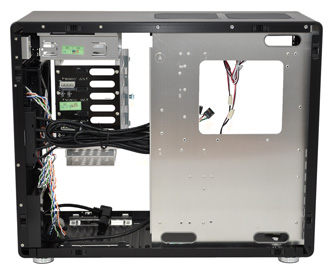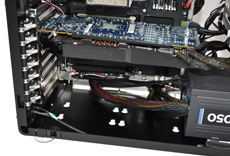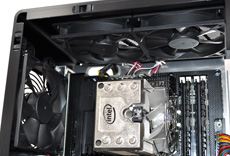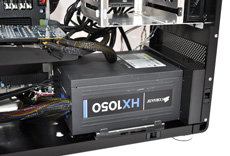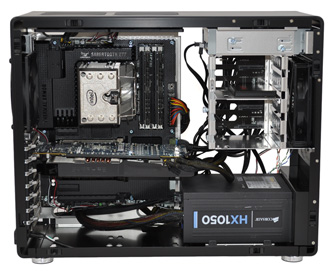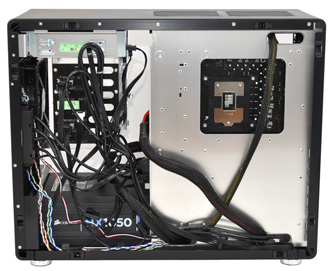Inside the PC-V700
From the outside, the PC-V700 looks faultless; it's relatively small, it's smart and the feature list suggests that you'll have no trouble filling it out with today's latest hardware. But only after you take away those clip-on side panels do you begin to fully realise that the PC-V700 isn't the roomiest of chassis.
In an effort to produce its smallest-ever ATX enclosure, Lian Li has cut the height of the chassis significantly. It's tough to get a true sense of size from these images, so here are some stats; the PC-V700 is 107mm shorter in height than a Corsair Graphite Series 600T and 96mm less deep.
This squeezed dimensions help save space and create a tidy-looking package, and Lian Li has worked around the lack of internal volume with a few neat ideas. The power-supply mount, for example, has been moved from the back of the chassis to the front. A pre-routed power cable is in place to ensure you plug-in at the normal point, but by moving the PSU the PC-V700 is able to offer eight expansion slots with a good amount of room for graphics cards measuring up to 440mm in length.
Moving the PSU to where the hard-disks are traditionally located could limit the chassis' storage capabilities, but Lian Li has a workaround for that, too. Below the top 5.25in optical bay is a neatly-integrated cage that offers four hot-swappable 3.5in hard-disk bays. Attached to the bottom of that is a small removable cage that offers two 2.5in drive bays, and right at the bottom of the chassis, to the left of where the PSU would sit, a further two 3.5in mounts are available if needed.
A healthy array of options for a chassis of this size, and the internal area is generally well thought out. The motherboard tray has a good-sized cutout for CPU cooler installation, the front USB 3.0 ports connect directly to a motherboard header (a 3.0-to-2.0 convertor is included in the bundle if needed), the two cable-routing holes are just big enough for a 24-pin power cable, and all eight expansion slots utilise Lian Li's high-quality, tool-free lever mechanism.
Lian Li's layout is logical, but working with the PC-V700 still requires a bit of time and patience. Unlike some of the company's bigger enclosures, you can't simply pile in all your hardware and there's a bit more work involved. To install the power supply, for example, you have to first undo four screws and remove the mounting bracket. This allows you fix a power supply measuring up to 180mm in length, plug in the routing cable, and re-attach the completed unit to the chassis where it rests above a pull-out dust filter.
Up top, there appears to be just enough room for a 240mm radiator plus fans, but we suspect such a configuration would make it near-impossible to route an eight-pin EPS power connector over the top of the board. And, while there's plenty of room for a single graphics card - our Sapphire Radeon HD 7950 OC fits in easily - you'll struggle to add a second discrete card into the mix.
We had a second card waiting on standby just in case the PC-V700 could support high-end CrossFire, but there isn't enough room for two Sapphire HD 7950s and a Corsair HX1050 power supply. Though, if you do have your heart set on a dual-GPU configuration, the PC-V700 has the expansion slots and it should be doable with two shorter graphics cards - we've measured it up and a pair of GeForce GTX 560 Tis seem a good fit, but even then we'd recommend a shorter power supply to make cabling that little bit easier.
Speaking of cables, making the PC-V700 look clean and tidy on the inside is easier said than done. There isn't a great amount of room behind the motherboard tray (you're looking at just under 20mm), and the large open space behind the hard-disk cage makes it tough to hide any excess cable.
The tighter confines are a valid concern - users wanting to run multiple GPUs and lots of liquid cooling without a cable in sight should look elsewhere - but Lian Li has nonetheless made good use of the space available. Our test build, pictured above, is no slouch and includes an ASUS Sabertooth Z77 motherboard, an overclocked Intel Core i7-3770K Ivy Bridge processor and a Sapphire Radeon HD 7950 OC graphics card.
There's plenty of potential for most users and the PC-V700 will house some seriously high-end builds, but does the restricted space hamper thermal performance? The front intake is obstructed by the hard-disk cage and the power supply is unusually positioned, so let's find out how warm the core components get under load.







